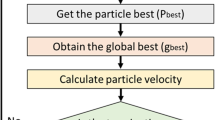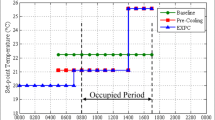Abstract
In modern building design, engineers are constantly facing challenging to find an optimal design to maintain a high level of thermal comfort and indoor air quality for occupants while minimizing the system energy consumption. Over the past decades, several algorithms have been proposed and developed for optimizing the heating, ventilation and air conditioning (HVAC) system for indoor environment. Nevertheless, majority of these optimization algorithms are focused on single objective optimization procedures and require large training sample for surrogate modelling. For multi-objective HVAC design problems, previous studies introduced an arbitrary weighting factor to combine all design objectives into one single objective function. The near optimal solutions were however sensitive to the chosen value of the weighting factor. Aiming to develop a multi-objective optimization platform with minimal computational cost, this paper presents a nondominated sorting-based particle swarm optimization (NSPSO) algorithm together with the Kriging method to perform optimization for the HVAC system design of a typical office room. In addition, an adaptive sampling procedure is also proposed to enable the optimization platform to adjust the sampling point and resolution in constructing the training sample. Significant computational cost could be reduced without sacrificing the accuracy of the optimal solution. The proposed methods are applied and assessed in a typical HVAC system and the results indicate that comparing to traditional methods, the presented approach can handle multi-objective optimization in ventilation system with up to 46.6% saving of computational time.
Similar content being viewed by others
References
Afrand M, Farahat S, Nezhad AH, Sheikhzadeh GA, Sarhaddi F, Wongwises S (2015). Multi-objective optimization of natural convection in a cylindrical annulus mold under magnetic field using particle swarm algorithm. International Communications in Heat and Mass Transfer, 60: 13–20.
Buratti C, Palladino D, Ricciardi P (2016). Application of a new 13-value thermal comfort scale to moderate environments. Applied Energy, 180: 859–866.
Buratti C, Ricciardi P (2009). Adaptive analysis of thermal comfort in university classrooms: correlation between experimental data and mathematical models. Building and Environment, 44: 674–687.
Buratti C, Ricciardi P, Vergoni M (2013). HVAC systems testing and check: A simplified model to predict thermal comfort conditions in moderate environments. Applied Energy, 104: 117–127.
Cardinale N, Stefanizzi P, Rospi G, Augenti V (2010). Thermal performance of a mobile home with light envelope. Building Simulation, 3: 331–338.
Carrese R, Sobester A, Winarto H, Li X (2011). Swarm heuristic for identifying preferred solutions in surrogate-based multi-objective engineering design. AIAA Journal, 49: 1437–1449.
Deb K (2001). Multi-objective Optimization Using Evolutionary Algorithms. Chichester, UK: John Wiley & Sons.
Deb K, Pratap A, Agarwal S, Meyarivan T (2002). A fast and elitist multiobjective genetic algorithm: NSGA-II. IEEE Transactions on Evolutionary Computation, 6: 182–197.
Fanger PO (1972). Thermal Comfort: Analysis and Applications in Environmental Engineering. New York: McGraw-Hill.
Forrester A, Sóbester A, Keane A (2008). Engineering Design via Surrogate Modelling: A Practical Guide. Chichester, UK: John Wiley & Sons.
Gangisetti K, Claridge DE, Srebric J, Paulus MT (2016). Influence of reduced VAV flow settings on indoor thermal comfort in an office space. Building Simulation, 9: 101–111.
Gano SE, Renaud JE, Martin JD, Simpson TW (2006). Update strategies for kriging models used in variable fidelity optimization. Structural and Multidisciplinary Optimization, 32: 287–298.
Gyulai L, Szabó S, De Kock DJ, Snyman JA (2007). A study of the feasibility of using mathematical optimisation to minimise the temperature in a smelter pot room. Building and Environment, 42: 2268–2278.
Hardwick J, Stout QF (2016). Adaptive Sampling Designs. University of Michigan. Available at http://web.eecs.umich.edu/~qstout/AdaptSample.html.
Hassan R, Cohanim B, De Weck O, Venter G (2005). A comparison of particle swarm optimization and the genetic algorithm. In: Proceedings of the 1st AIAA Multidisciplinary Design Optimization Specialist Conference, Austin, USA.
Hiyama K, Kato S, Ishida Y (2010). Thermal simulation: Response factor analysis using three-dimensional CFD in the simulation of air conditioning control. Building Simulation, 3: 195–203.
Journel AG, Huijbregts CJ (1978). Mining Geostatistics. London: Academic Press.
Kennedy J (2001). Swarm Intelligence. San Francisco: Morgan Kaufmann Publishers.
Kochetov N, Loktionov V, Sidorov A (2015). Using the Star CCM+ software system for modeling the thermal state and natural convection in the melt metal layer during severe accidents in VVER reactors. Thermal Engineering, 62: 663–672.
Krauss G, Kindangen J, Depecker P (1997). Using artificial neural networks to predict interior velocity coefficients. Building and Environment, 32: 295–303.
Laverge J, Janssens A (2013). Optimization of design flow rates and component sizing for residential ventilation. Building and Environment, 65: 81–89.
Li K, Su H, Chu J, Xu C (2013a). A fast-POD model for simulation and control of indoor thermal environment of buildings. Building and Environment, 60: 150–157.
Li K, Xue W, Xu C, Su H (2013b). Optimization of ventilation system operation in office environment using POD model reduction and genetic algorithm. Energy and Buildings, 67: 34–43.
Li X (2003). A non-dominated sorting particle swarm optimizer for multiobjective optimization. In: Proceedings of Genetic and Evolutionary Computation Conference, Chicago, USA, pp. 37–48.
He H-D, Lu W-Z, Xue Y (2014). Prediction of particulate matter at street level using artificial neural networks coupling with chaotic particle swarm optimization algorithm. Building and Environment, 78: 111–117.
Luh GC, Lin CY (2011). Optimal design of truss-structures using particle swarm optimization. Computers and Structures, 89: 2221–2232.
Martínez SZ (2013). Use of gradient-free mathematical programming techniques to improve the performance of multi-objective evolutionary algorithms. PhD Thesis, National Polytechnic Institute of Mexico, Mexico.
Nematchoua MK, Tchinda R, Ricciardi P, Djongyang N (2014). A field study on thermal comfort in naturally-ventilated buildings located in the equatorial climatic region of Cameroon. Renewable and Sustainable Energy Reviews, 39: 381–393.
Ravikumar P, Prakash D (2009). Analysis of thermal comfort in an office room by varying the dimensions of the windows on adjacent walls using CFD: A case study based on numerical simulation. Building Simulation, 2: 187–196.
Ricciardi P, Buratti C (2015). Thermal comfort in the Fraschini theatre (Pavia, Italy): Correlation between data from questionnaires, measurements, and mathematical model. Energy and Buildings, 99: 243–252.
Ricciardi P, Ziletti A, Buratti C (2016). Evaluation of thermal comfort in an historical Italian opera theatre by the calculation of the neutral comfort temperature. Building and Environment, 102: 116–127.
Stavrakakis GM, Karadimou DP, Zervas PL, Sarimveis H, Markatos NC (2011). Selection of window sizes for optimizing occupational comfort and hygiene based on computational fluid dynamics and neural networks. Building and Environment, 46: 298–314.
Tu J, Yeoh GH, Liu C (2008). Computational Fluid Dynamics: A Practical Approach. Burlington, MA, USA: Butterworth-Heinemann.
Varol Y, Avci E, Koca A, Oztop HF (2007). Prediction of flow fields and temperature distributions due to natural convection in a triangular enclosure using Adaptive-Network-Based Fuzzy Inference System (ANFIS) and Artificial Neural Network (ANN). International Communications in Heat and Mass Transfer, 34: 887–896.
Welle B, Haymaker J, Rogers Z (2011). ThermalOpt: A methodology for automated BIM-based multidisciplinary thermal simulation for use in optimization environments. Building Simulation, 4: 293–313.
Yan Y, Li X, Tu J (2014). Numerical study of passenger thermal effects on the transport characteristics of exhaled droplets in an airliner cabin. In: Proceedings of the 13th International Conference on Indoor Air Quality and Climate, Hong Kong, China.
Yuan X, Chen Q, Glicksman LR, Hu Y, Yang X (1999). Measurements and computations of room airflow with displacement ventilation. ASHRAE Transactions, 105(1): 340–350.
Zhai Z, Xue Y, Chen Q (2014). Inverse design methods for indoor ventilation systems using CFD-based multi-objective genetic algorithm. Building Simulation, 7: 661–669.
Zhao B (2009). Modeling pressure drop coefficient for cyclone separators: A support vector machine approach. Chemical Engineering Science, 64: 4131–4136.
Zhou L, Haghighat F (2009a). Optimization of ventilation system design and operation in office environment, Part I: Methodology. Building and Environment, 44: 651–656.
Zhou L, Haghighat F (2009b). Optimization of ventilation systems in office environment, Part II: Results and discussions. Building and Environment, 44: 657–665.
Acknowledgements
The financial support provided by an Australian Research Council grant (ARC Linkage LP130100236) is gratefully acknowledged.
Author information
Authors and Affiliations
Corresponding author
Rights and permissions
About this article
Cite this article
Li, N., Cheung, S.C.P., Li, X. et al. Multi-objective optimization of HVAC system using NSPSO and Kriging algorithms—A case study. Build. Simul. 10, 769–781 (2017). https://doi.org/10.1007/s12273-017-0352-5
Received:
Revised:
Accepted:
Published:
Issue Date:
DOI: https://doi.org/10.1007/s12273-017-0352-5




